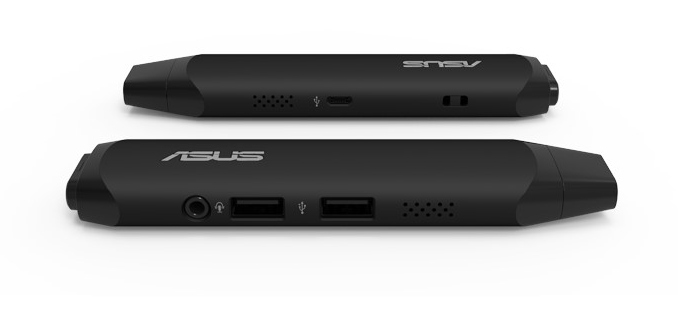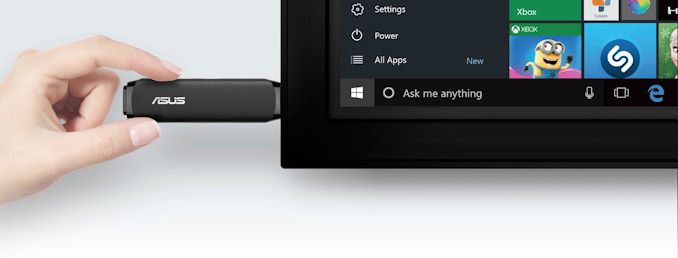ASUS Upgrades Compute Stick: The VivoStick TS10 Gets More RAM, Storage, & Windows 10 Pro
by Anton Shilov on February 19, 2020 7:00 PM EST- Posted in
- Desktop
- Systems
- Atom
- Asus
- Cherry Trail
- Compute Stick
- VivoStick

Intel’s Compute Stick, a self-contained PC-on-a-stick that could be used to transform any display into a PC, was an interesting concept when it was revealed several years ago. However it never really took off in the intervening years, due in part to limitations imposed by the form factor, leading to the chipmaker to abandon the project. Still, the Compute Stick did find a small but apparently loyal user base who remained interested in the niche solution, and so this week ASUS is introducing a new version of its VivoStick PC TS10 with more RAM and Windows 10 Pro.
First introduced back in 2017, the original ASUS VivoStick PC TS10 was based on Intel’s Atom x5-Z8350 SoC (Cherry Trail with 4 Airmont CPU cores), which was accompanied by 2 GB of LPDDR3-1600 memory as well as 32 GB of eMMC storage. The newly updated VivoStick PC TS10, model TS10-B174D, sticks with the same chassis and uses the same SoC, but it is now equipped with 4 GB of LPDDR3 memory as well as 64 GB of storage. Furthermore, the new unit also runs Microsoft’s Windows 10 Pro, replacing Windows 10 Home used in the original model.
Otherwise, the VivoStick is essentially unchanged from its earlier incarnation. The unit has two USB Type-A ports (2.0 & 3.0), a Micro USB connector for power, an combo audio jack, and an HDMI 1.4 connector for video out.
The original VivoStick TS10 with Windows 10 Home was designed primarily with consumer and SOHO applications in mind, and many retailers still sell it as a media streaming player that offers Windows 10 flexibility and can run loads of applications. But with the updated VivoStick TS10, ASUS seems to be broadening their niche just a bit, especially with access to Pro-focused features like Active Directory support and Microsoft Update for Business. Potentially, this means that ASUS can position the new VivoStick PCs differently and aim customers who need cheap miniature computers with business-class features and security.
So far, ASUS has introduced its revamped VivoStick PC TS10 in Japan and has not disclosed its pricing. All told, it is pretty strange for a PC maker to introduce an improved version of a three-year old product, so it will be interesting to see just what ASUS has in mind for their updated compute stick.
Related Reading:
- The Intel Compute Stick (Core m3-6Y30) Review
- The Intel Compute Stick (Cherry Trail) Review
- Intel Expands Compute Stick Family with Cherry Trail and Core M Models
Source: ASUS Japan (via Hermitage Akihabara)











35 Comments
View All Comments
watzupken - Wednesday, February 19, 2020 - link
If they are upgrading the Compute Stick, they might as well change the SOC. I am not sure if the Atom chip is going to keep up with the requirements of WIndows in the near future. And to be honest, the likes of Raspberry PI is starting to catch up with them.nandnandnand - Wednesday, February 19, 2020 - link
This seems like a good form factor to stick that 5-core Lakefield chip in.yeeeeman - Thursday, February 20, 2020 - link
Exactly what I was thinking.Spunjji - Thursday, February 20, 2020 - link
Yup. That and 8GB of RAM and it'd actually be usable for a lot of things. Who cares if the price goes up a bit - this is basically e-waste in fancy packaging.atifz - Thursday, February 20, 2020 - link
I also concur the Lakefield would make a formidable compute stick device. The retro-computing possibilities are endless! I own 3 VivoSticks and love them for retro stuff! I can run old Silicon Graphics demos on these devices way faster than the 500K InfiniteReality supercomputers of yesteryear! I own an O2 and the VivoStick runs circles around it!mode_13h - Friday, February 21, 2020 - link
That Cherry Trail SoC is a 2 W part. You can't dissipate much heat from a stick form factor (remember, being an external device, it mustn't get hot enough to burn someone).Do we have a part number on Lakefield? I wonder how low you'd have to clock it, to stay within 2W.
nandnandnand - Friday, February 21, 2020 - link
The shell appears to be made of plastic. ASUS can make the stick out of aluminum or something to dissipate more heat. This is the approach taken by the RTL-SDR USB sticks. No, it won't burn you if done properly.Previously, Intel said Lakefield could get down to as low as 3W. It seems that it will be at 7W in typical designs.
mode_13h - Friday, February 21, 2020 - link
Also, I'm sure Lakefield isn't cheap. The CPU, alone, could be a multiple of the current stick's price.It wouldn't be a bad compromise to drop the Sunny Cove core and just go with 4x Tremont cores, in a conventional 2D package. The Sunny Cove probably wouldn't be able to clock high enough to stretch its legs, anyhow.
nandnandnand - Friday, February 21, 2020 - link
The small/big approach looks like a good way to boost single-threaded performance, and it can let Intel mix process nodes. So they can make the big core on 10nm+ and small ones on 14nm+++++++, etc.Intel is overcharging for a lot of its products, but people still buy them. A better chip could turn this form factor from aggravating to useful. At a minimum, looks like it needs a fresher Atom with 4K H.265 decode support.
Jorgp2 - Thursday, February 20, 2020 - link
Even the newest atom at the same TDP would offer double the performance.